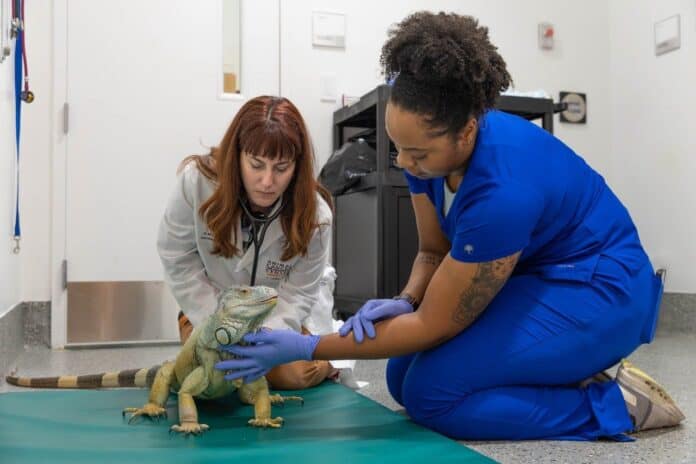“How much is that doggie — uh, iguana — in the window?” Tom Smith pondered that question many times making frequent visits to the Petco pet care center in Roanoke’s Towers Shopping Center.
“I visited every day on my lunch,” Smith said. “I would go every single day for almost a month and send pictures to my wife, Melissa. He just kind of stole my heart. Finally, I think it was a weekend, she and I went to see if he was still there, and he was. I almost dropped to my knees and begged, and she finally said, ‘All right.’”
With such an emotional and financial investment in their beloved pet iguana Echo, the Smiths were not about to give up easily when Echo — now 6 feet long after coming home in 2020 at 7 inches — developed a cancerous tumor called a sarcoma near his left eye. That eventually led them to the Virginia Tech’s Animal Cancer Care and Research Center.
“Some animals just have angels for owners,” said Roanoke exotic pet veterinarian Paul Stewart. “Those angels find other angels to get them through a tough spot.”
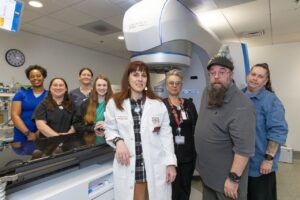
Advanced cancer treatment
After two rounds of surgery and biopsy by Stewart, the Smiths were directed to Animal Cancer Care and Research Center, a cutting-edge animal cancer treatment and translational research center on Virginia Tech’s Health Sciences and Technology campus in Roanoke. It is also one of three teaching hospitals of the Virginia-Maryland College of Veterinary Medicine, located on Blacksburg campus.
At the center, advanced focused radiation techniques, guided by the radiation oncology expertise of Ilektra Athanasiadi and supported by anesthesia clinicians Toshitsugu Ishihara and Li-Jen Chang, adept at the tender care of a cold-blooded reptile, gave Echo a new lease on life.
“This was new for us, and we needed to be flexible and a little bit different in how we do things,” Athanasiadi said. Dogs and cats are the center’s typical patients. Only a handful of iguanas have ever been treated for cancer through radiation anywhere at any time, clinicians found in preparing for Echo.
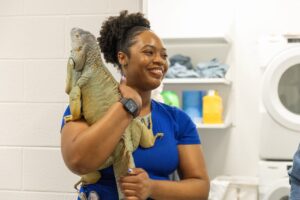
Petco Love support
National nonprofit Petco Love provided a lifesaving investment for Echo’s treatment. Petco Love is committed to supporting treatment for pets fighting cancer, furthering pet cancer research, and raising awareness about early detection of pet cancer. Partnering with Blue Buffalo, Petco Love grants the Animal Cancer Care and Research Center funds each year to partially or fully cover costs for those who have difficulty affording cancer treatment for their pets.
Initially, Stewart, a 1990 Virginia Tech graduate in animal sciences and a Kansas State University veterinary college alum, removed the sarcoma surgically, but the cancer partially grew back. After a second deeper surgery by Stewart, including cauterizing tissue behind the sarcoma, the Smiths followed up at Animal Cancer Care and Research Center for radiation treatment on Echo.
After using an advanced linear accelerator to focus radiation in four treatment sessions precisely on the cells near where the cancerous growth had been removed, clinicians now see no evidence that Echo’s cancer is regrowing, though he will continue to be closely monitored.
“With the technology that we have here, the machine, the treatment planning techniques, we were able to focus the beam on the lesion and not get much of the dose in the left eye,” said Athanasiadi, clinical assistant professor of radiation oncology. “And I’m pleased with the results.”
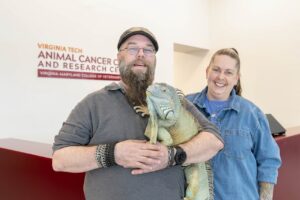
“Echo really knows no strangers”
The Smiths hung Echo’s certificate of completing his radiation treatments in their home, which is also the home of a caramel ball python, three bearded dragons, three dogs, and nine cats.
“Of all the animals, one of Echo’s best friends is a cat,” Tom Smith said. “All the animals enjoy hanging out with him.” Well, except for one bearded dragon, he added.
Echo is fully potty trained, Tom Smith said, and obeys several commands, such as “get on the couch,” “get in the water,” and “come on.” He has a habitat in a bedroom but also has free rein to come and go through the house.
“He’s more of a dog than some of our dogs,” Tom Smith said.
“People often have the assumption that reptiles are standoffish, or can’t develop that bond, but clearly it’s not the case with Echo,” Melissa Smith said.
Stewart said it’s unusual for exotic pet owners to go to the lengths the Smiths did to get treatment for Echo, but then, the Smiths are unusual exotic pet owners in other ways.
“Echo has had an unusually low-stress life because the owners have positively reinforced good behavior,” Stewart said. “Echo really knows no strangers. He’s easy to handle, not defensive or aggressive. We usually have to throw on gloves to handle these lizards, but we can carry him like a puppy dog. He is an exceptional iguana.
“That’s why he has such a bond with his parents, and parents willing to do with that they did to help him.”
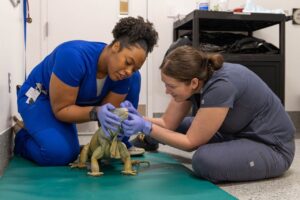
The challenges of treating iguanas
Treating an iguana for cancer is not an everyday thing for even the most experienced veterinary clinicians.
“I was excited, but also a little bit scared,” Athanasiadi said. “Mostly my fears were concerns with anesthesia. They are very special for anesthesia, and we consulted with our anesthesia group, and they were here to help us.”
Toshitsugu Ishihara and Li-Jen Chang, clinical assistant professors in the anesthesiology department at the Veterinary Teaching Hospital in Blacksburg, assisted the Animal Cancer Care and Research Center with Echo during an inital CT scan and four radiation treatments.
Iguanas present unique challenges compared to the dogs and cats more frequently treated at the center.
Sedation by intramuscular injection is the first step for smooth induction without overly exciting the animal, which often attempt to resist retraints and intravenous catheters. However, the thick scaly skin is difficult to penetrate, and the skin makes it exceedingly difficult to place an intravenous catheter. In addition, there is little information available on the appropriate dosage and combinations of anesthesia for iguanas, making it difficult to adjust the dosage.
Also, this injection is given only in front limbs and upper body, as injections given in the lower body go to the iguana’s kidneys first, possibly causing renal damage. This is unlike the circulatory systems of mammals, in which even lower-body injections travel through the heart and lungs first.
Once sedated, the iguana was given inhalation anesthesia through an endotracheal tube.
Chang served seven years as a zoo veterinarian in Taiwan and had previously helped anesthetize iguanas and other reptiles, but this case was novel for him. “This is the first radiation therapy in a reptile for me,” Chang said.
Ishihara said Echo’s case report will be valuable far beyond Virginia Tech.
“We will share the information to help develop more of a smooth procedure for the next iguana,” Ishihara said. “It’s very different from the dogs and cats.”
Clinicians used a warming table to keep Echo’s body warm and also intubated him to make sure he had the proper supply of oxygen during the treatments.
“I would say that this is always a team effort, with each member bringing specialized expertise— from the radiation therapists who operate the linear accelerator, to the medical dosimetrist and physicist who carefully tailor each treatment plan to the individual needs of the patient. Every step, from planning to delivery, is a coordinated process to ensure the best possible outcome,” Athanasiadi said. “Licensed veterinary technicians play a big role too. By myself, I wouldn’t be able to do any of this for any patient.”
By Kevin Myatt

